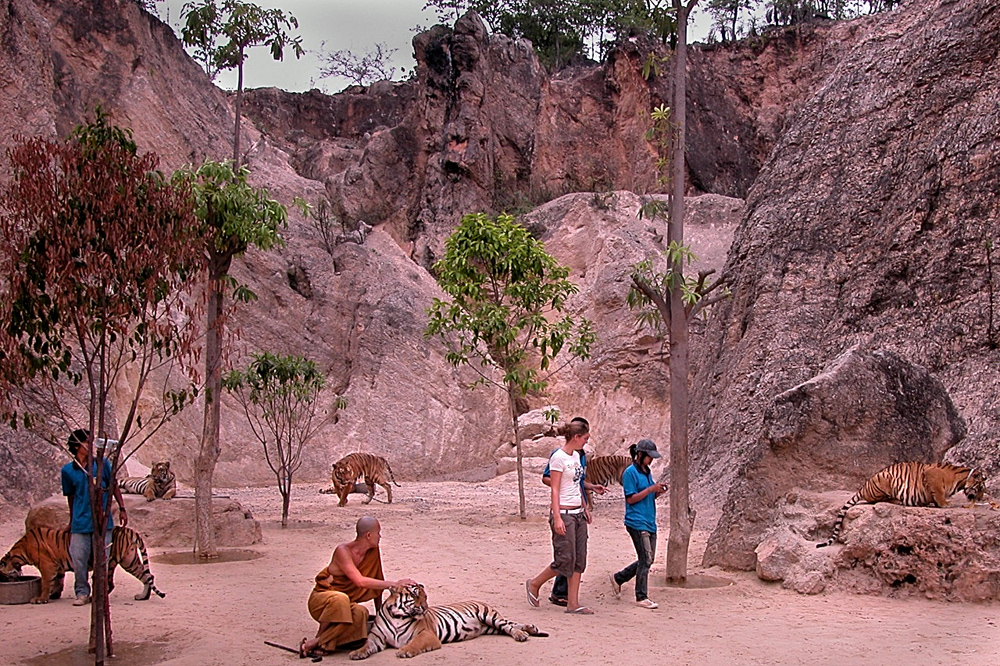In the disputed Tiger Temple Wat Pa Luangta Bua Yannasampanno
The Tiger Temple is called Wat Pa Luangta Bua Yannasampanno Forest Monastery and was established by the Abbot-Phra Acharn Phusit (Chan) Kanthitharo in 1994.
Since its opening Wat Pa Luangta Bua gained a reputation as a wildlife sanctuary. It started with an injured wild fowl given to the monk by the villagers, then peacocks came attracted by the calls of by then rather large colony of wild fowl. An injured wild boar stumbled in to the monastery and the monks cared for him until he could be released back into the forest. The next day he came back followed by his family group of about 10 animals. By now a countless number of boar find shelter in the monastery. Villagers also started to bring in unwanted pets: four species of deer moved in, followed by buffalo, cow, horses, wild goat and gibbons. All these animals are roaming the grounds of the monastery freely.
The first tiger cub arrived to the monastery in February 1999. It was a female cub of Indochinese subspecies (Tigris corbetti) and her condition was very poor. When she was only a few months old her mother was killed by poachers near the Thai-Burma border. The cub was sold to and the new owner ordered her stuffed. A local was hired to do the job, which fortunately he did not finish. Although he injected her in the neck with the preservative formalin the cub survived. When she arrived to the to the monastery she was frail and terrified of a slightest sound. She still has stitches in the cuts on her head. Her vision was impaired and her teeth were already worn, particularly the fangs, which appeared as if they have been filed down to the gum, blood oozing from the roots. Eating was a difficult task for her - she could hardly move her tongue, chew and swallow her food. Inspite of her condition she has never once attacked anyone. Under loving care of the monks the cub recovered, but in July 1999 she fell seriously ill with heart palpitations and died.
Now the image of this tempel has become very dubious:
In December 2008, ABC News spent three days at the temple and did not see any evidence of drugging or mistreating the animals. Both Thai and Western employees who were interviewed claimed that the animals were well treated. The abbot of the monastery stated that the eventual goal was to breed tigers for release in the wild.
There’s nothing wrong in maintaining a temple for orphaned animals, and also earning the necessary income by charging entrance fees to support the temple and the animals is ok. I do however criticise local authorities for keeping the temple’s activities illegal. The only purpose for doing so is to gain access to a large part of the temple’s income, so that unscrupulous local officers can fill their pockets – and that’s certainly not ok.










Edi Ogris 26/12/2013 20:26
Eine sehr schöne Aufnahme vom Tigertempel,werde den Besuch bei den Tigern und Mönchen nie vergessen
Grüße aus Tirol
Edi
Pfriemer 18/11/2013 11:41
Danke für die Kommentare, doch muss ich unbedingt klar stellen, dies ist kein Urlaubsknips (ich bin nicht in Urlaub in Thailand), sondern meine Dokumentation und Darstellung über den mittlerweile total mit Recht verrufenen Tigertempel.Wie schon in meinem Profil beschrieben, aus einem ursprünglich guten Zweck, verwaisten und ausgesetzten Tieren ein Asyl zu geben, wurde von miesen Lokalpolitikern und korrupen Behörden schon nach kurzer Zeit eine Quelle gefunden, am Tourismus abzusahnen. Das Kloster selbst hat davon nur wenig Nutzen. Es sind hier die Falschen die am naiven Tourismus wieder den Raibach machen.
Liebe Sylvia, seit 1999 besuche ich den Tigertempel und sehe, wie die Tiere mit einer ganz speziellen Diät in der Defensive gehalten werden, sie bekommen nach meinen besten Wissen KEINE Drogen, wenn man das Wort Droge so annimmt wie es weltweit falsch kriminalisiert wird. Pfefferminztee ist auch eine Droge und der Drogerist um die Ecke ein Drogenhändler.
Die Tiger bekommen Leder zu kauen und niemals rohes Fleisch.
Die ersten Tiger wurden im Kloster aufgenommen und aufgezogen nachdem sie vorher ausgesetzt waren. diese Tiger wären qualvoll verendet, denn sie könnten sich niemals in der freien Natur einleben.
Irgendwelche gedankenlose Superreiche halten sich immer wieder eigene Privatzoos, nicht nur mit Tigern. Später, wenn diese Tiere dann die Geschlechtsreife erreichen und die Haltung eines wilden Tieres immer schwieriger wird, setzen sie das Tier gewissenlos aus. Auch solche Zeitgenossen tragen zu diesen Missstand bei und sind ebenfalls zu ächten.
Grüße aus Bangkok Wolfgang
wico twelve 17/11/2013 10:39
hübscher urlaubsknips